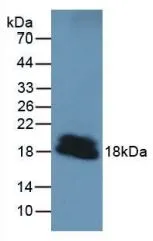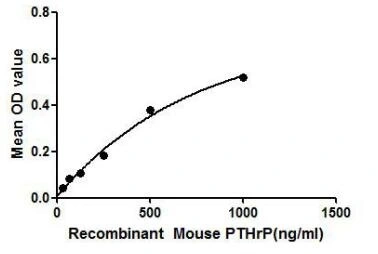
WB analysis of GTX00047-pro Mouse PTHrP protein.
Mouse PTHrP protein, His tag
GTX00047-PRO
ApplicationsFunctional Assay
Product group Proteins / Signaling Molecules
Protein IDP22858
Overview
- SupplierGeneTex
- Product NameMouse PTHrP protein, His tag
- Delivery Days Customer9
- Application Supplier NotePTHrP (Parathyroid Hormone Related Protein ) is a neuroendocrine peptide which is a critical regulator of cellular and organ growth, development, migration, differentiation and survival and of epithelial calcium ion transport. Regulates endochondral bone development and epithelial-mesenchymal interactions during the formation of the mammary glands and teeth. A binding ELISA assay was conducted to detect the association of PTHrP with PTHR1. Briefly, PTHrP were diluted serially in PBS, with 0.01% BSA (pH 7.4). Duplicate samples of 100 microl PTHrP were then transferred to PTHR1-coated microtiter wells and incubated for 2h at 37C. Wells were washed with PBST and incubated for 1h with anti-PTHrP pAb, then aspirated and washed 3 times. After incubation with HRP labelled secondary antibody, wells were aspirated and washed 3 times. With the addition of substrate solution, wells were incubated 15-25 minutes at 37C. Finally, add 50 microl stop solution to the wells and read at 450nm immediately. The binding activity of PTHrP and PTHR1 was in a dose dependent manner.
- ApplicationsFunctional Assay
- CertificationResearch Use Only
- ConjugateUnconjugated
- Protein IDP22858
- Protein NameParathyroid hormone-related protein
- Scientific DescriptionThis gene encodes a member of the parathyroid family of hormones that possesses distinct paracrine and intracrine signaling roles such as regulation of circulating calcium, transplacental calcium transport, osteoclast inhibition, renal bicarbonate excretion and regulation of apoptosis. The encoded protein undergoes proteolytic processing to generate multiple active peptides with distinct signaling functions. The homozygous deletion of this gene leads to death shortly after birth with a chondrodystrophic phenotype characterized by premature chondrocyte differentiation and accelerated bone formation. [provided by RefSeq, Jul 2015]
- Storage Instruction-20°C or -80°C,2°C to 8°C
- UNSPSC51180000


